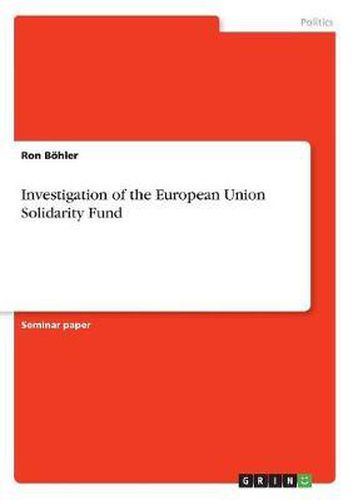Readings Newsletter
Become a Readings Member to make your shopping experience even easier.
Sign in or sign up for free!
You’re not far away from qualifying for FREE standard shipping within Australia
You’ve qualified for FREE standard shipping within Australia
The cart is loading…






Seminar paper from the year 2012 in the subject Politics - International Politics - Topic: European Union, grade: 1.3, Humboldt-University of Berlin, language: English, abstract: The aim of this essay is it to move beyond pure evaluations of the EUSF’s efficiency and viability and to target its social dimension. The argument elaborated here is that natural hazard insurance mechanisms on the European level effectively complement national ones and that this cannot be fully explained with rational behaviour. The EUSF might be a test case for inter-European solidarity transfer payments irrespective of rational cost-benefit calculations, though it seems to share most attributes with the EU Cohesion and Regional Policy. For decades, European unification has been illustrated ordinarily as a mere economic integration process that lacks a complementary political dimension, let alone a social one. Even more in times of the current sovereign debt crisis that continuingly bears the potential to threaten both the stability and competitiveness of a series of market economies, the European Union (EU) is expected to succeed or fail with its common Eurozone currency, the Euro. It’s the economy, stupid!, one might say. Yet, while national governments and European policy-makers incessantly discuss about adequate ways of political steering of shattered European financial regulations, the EU has over the years installed institutions and mechanisms that shall strengthen and deepen the European project, but have only reluctantly gained academic and public attention. Much has been already written about the EU regional policy and structural funding through the European Regional Development Fund (ERDF) and the European Social Fund (ESF) as attempts to improve social cohesion within Europe. Another institutionalised form of intra-European solidarity, in contrast, remains overall a blind spot in academic literature although its name is a clear avowal to European solidarity: the European Un
$9.00 standard shipping within Australia
FREE standard shipping within Australia for orders over $100.00
Express & International shipping calculated at checkout
Seminar paper from the year 2012 in the subject Politics - International Politics - Topic: European Union, grade: 1.3, Humboldt-University of Berlin, language: English, abstract: The aim of this essay is it to move beyond pure evaluations of the EUSF’s efficiency and viability and to target its social dimension. The argument elaborated here is that natural hazard insurance mechanisms on the European level effectively complement national ones and that this cannot be fully explained with rational behaviour. The EUSF might be a test case for inter-European solidarity transfer payments irrespective of rational cost-benefit calculations, though it seems to share most attributes with the EU Cohesion and Regional Policy. For decades, European unification has been illustrated ordinarily as a mere economic integration process that lacks a complementary political dimension, let alone a social one. Even more in times of the current sovereign debt crisis that continuingly bears the potential to threaten both the stability and competitiveness of a series of market economies, the European Union (EU) is expected to succeed or fail with its common Eurozone currency, the Euro. It’s the economy, stupid!, one might say. Yet, while national governments and European policy-makers incessantly discuss about adequate ways of political steering of shattered European financial regulations, the EU has over the years installed institutions and mechanisms that shall strengthen and deepen the European project, but have only reluctantly gained academic and public attention. Much has been already written about the EU regional policy and structural funding through the European Regional Development Fund (ERDF) and the European Social Fund (ESF) as attempts to improve social cohesion within Europe. Another institutionalised form of intra-European solidarity, in contrast, remains overall a blind spot in academic literature although its name is a clear avowal to European solidarity: the European Un